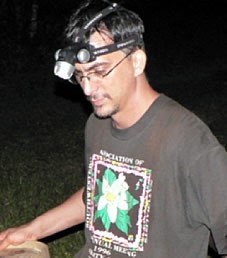Dr. Richard Stevens
Email: richard.stevens@ttu.edu
Phone: (806) 834-6843
Office: Goddard Hall 007-D
Ph.D., Texas Tech University, 2002
Lab Website

Research Interests
My interests lie at the intersection of community ecology, macroecology, and biogeography. Part of my work examines the basic community ecology of bats and rodents in Paraguay, California and Texas, in particular the effects of species environment interactions, dispersal, seasonality and competition on the structure of communities. I am also interested in the mechanistic bases of broad-scale patterns in the structure and diversity of communities and how to use this information to better conserve the world's biota. Typically I explore spatial variation of New World mammals, particularly bats, using indices that incorporate information regarding multiple dimensions of biodiversity.
Service
I am associate editor of the Journal of Mammalogy and serve on the Publications Advisory Board and the Animal Care and Use Committee of the American Society of Mammalogists.
Courses Taught
- NRM 5403 Experimental Design and Analysis
- NRM 6002 Biometry ll
Recent Publications
D. A. Ray, Pagan, H. J. T., Platt, R. N., Schaack, S. and Stevens R. D. 2015. Differential SINE evolution in vesper and non-vesper bats. Mobile DNA, In Press.
R. D. Stevens and N. Platt. 2015. Patterns of secondary sexual size dimorphism in New World Myotis and a test of Rensch's Rule. Journal of Mammalogy, In Press.
R. D. Stevens and M. M. Gavilanez. 2015. Dimensionality of community structure: phylogenetic, phenetic and functional perspectives along biodiversity and environmental gradients. Ecography, In Press.
R. D. Stevens and J. S. Tello. 2014. On the measurement of dimensionality of biodiversity. Global Ecology and Biogeography 23: 1115-1125.
M. de Moraes Weber, R. D. Stevens, and C. E. V. Grelle. 2014. Have young species reached most environmentally suitable areas? A case study with South American phyllostomid bats. Global Ecology and Biogeography 23: 1177-1185.
L. E. Patrick and R. D. Stevens. 2014. Investigating sensitivity of phylogenetic community structure metrics using North American desert bats. Journal of Mammalogy 95: 1240-1253.
Department of Natural Resources Management
-
Address
Goddard Building, Texas Tech University, Box 42125, Lubbock TX 79409 -
Phone
806.742.2841 -
Email
nrm@ttu.edu
